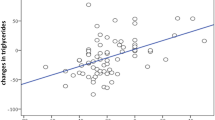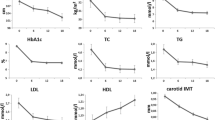Abstract
Aim
In addition to the effects on glycemic control and body weight, GLP-1 receptor agonists may favorably affect other major cardiovascular disease (CVD) risk factors, although currently available data are still sparse. In this retrospective study, we evaluated the effects of 12-month treatment with liraglutide on major CVD risk factors in 115 type 2 diabetes outpatients (60 men and 55 women), on stable hypoglycemic, anti-hypertensive and/or lipid-lowering therapy.
Methods
Clinical and anthropometric data, metabolic and lipid profile, as well as the Visceral Adiposity Index (VAI), an obesity-related CVD risk factor, were measured in all participants at baseline and after 12-month treatment.
Results
Treatment with liraglutide was associated with a significant reduction from baseline values of fasting blood glucose (−42.1 mg/dl, P < 0.05), HbA1c (−1.5 %, −17 mmol/mol, P < 0.05), body weight (−7.1 kg, P < 0.05), waist circumference (-6.8 cm, P < 0.001), total-cholesterol (−27.4 mg/dl, P < 0.05), LDL-cholesterol (−25.4 mg/dl, P < 0.05), triglycerides (−56.1 mg/dl, P < 0.05), and non-HDL-C (−36.6 mg/dl, P < 0.05) and an increase of HDL-cholesterol concentrations (+9.3 mg/dl, P < 0.001), a significant reduction in both systolic and diastolic blood pressure (−14.7 mmHg, P < 0.001 and −9.0 mmHg, P < 0.05, respectively) and a decrease of VAI values (−1.6, P < 0.001). All these differences were independent of changes in BMI and comparable in men and women.
Conclusions
In conclusion, 12-month treatment with liraglutide in add-on to on-going hypoglycemic therapy significantly ameliorates all major CVD risk factors and reduces cardiometabolic risk, as estimated by VAI values.

Similar content being viewed by others
Abbreviations
- CVD:
-
Cardiovascular disease
- T2D:
-
Type 2 diabetes
- GLP-1RAs:
-
Glucagon-like peptide-1 receptor agonists
- VAI:
-
Visceral Adiposity Index
References
Wild S, Roglic G, Green A, Sicree R, King H (2004) Global prevalence of diabetes: estimates for the year 2000 and projections for 2030. Diabetes Care 27:1047–1053
Buse JB, Ginsberg HN, Bakris GL et al (2007) Primary prevention of cardiovascular diseases in people with diabetes mellitus: a scientific statement from the American Heart Association and the American Diabetes Association. Circulation 115:114–126
Liu SC, Tu YK, Chien MN, Chien KL (2012) Effect of antidiabetic agents added to metformin on glycaemic control, hypoglycaemia and weight change in patients with type 2 diabetes: a network meta-analysis. Diabetes Obes Metab 14:810–820
Drucker DJ, Nauck MA (2006) The incretin system: glucagonlike peptide-1 receptor agonists and dipeptidyl peptidase-4 inhibitors in type 2 diabetes. Lancet 11(368):1696–1705
Vilsbøll T, Christensen M, Junker AE, Knop FK, Gluud LL (2012) Effects of glucagon-like peptide-1 receptor agonists on weight loss: systematic review and meta-analyses of randomised controlled trials. BMJ 344:d7771
Vilsbøll T, Garber AJ (2012) Non-glycaemic effects mediated via GLP-1 receptor agonists and the potential for exploiting these for therapeutic benefit: focus on liraglutide. Diabetes Obes Metab 14(Suppl 2):41–49
Marre M, Shaw J, Brändle M et al (2009) LEAD-1 SU study group. Liraglutide, a once-daily human GLP-1 analogue, added to a sulphonylurea over 26 weeks produces greater improvements in glycaemic and weight control compared with adding rosiglitazone or placebo in subjects with type 2 diabetes (LEAD-1 SU). Diabet Med 26:268–278
Nauck M, Frid A, Hermansen K et al (2013) Long-term efficacy and safety comparison of liraglutide, glimepiride and placebo, all in combination with metformin in type 2 diabetes: 2-year results from the LEAD-2 study. Diabetes Obes Metab 15:204–212
Garber A (2011) Henry RR, Ratner R, Hale P, Chang CT, Bode B; LEAD-3 (Mono) Study Group. Liraglutide, a once-daily human glucagon-like peptide 1 analogue, provides sustained improvements in glycaemic control and weight for 2 years as monotherapy compared with glimepiride in patients with type 2 diabetes. Diabetes Obes Metab 13:348–356
Zinman B, Gerich J, Buse JB et al (2009) LEAD-4 Study investigators. Efficacy and safety of the human glucagon-like peptide-1 analog liraglutide in combination with metformin and thiazolidinedione in patients with type 2 diabetes (LEAD-4 Met + TZD). Diabetes Care 32:1224–1230
Russell-Jones D, Vaag A, Schmitz O et al (2009) Liraglutide effect and action in diabetes 5 (LEAD-5) met + SU study group. Liraglutide vs insulin glargine and placebo in combination with metformin and sulfonylurea therapy in type 2 diabetes mellitus (LEAD-5 met + SU): a randomised controlled trial. Diabetologia 52:2046–2055
Buse JB, Rosenstock J, Sesti G et al (2009) LEAD-6 study group. Liraglutide once a day versus exenatide twice a day for type 2 diabetes: a 26-week randomised, parallel-group, multinational, open-label trial (LEAD-6). Lancet 374:39–47
Klonoff DC, Buse JB, Nielsen LL et al (2008) Exenatide effects on diabetes, obesity, cardiovascular risk factors and hepatic biomarkers in patients with type 2 diabetes treated for at least 3 years. Curr Med Res Opin 24:275–286
Wang B, Zhong J, Lin H et al (2013) Blood pressure -lowering effects of GLP-1 receptor agonists exenatide and liraglutide: a meta-analysis of clinical trials. Diabetes Obes Metab 15:737–749
Inoue K, Maeda N, Kashine S et al (2011) Short-term effects of liraglutide on visceral fat adiposity, appetite, and food preference: a pilot study of obese Japanese patients with type 2 diabetes. Cardiovasc Diabetol 10:109
Amato MC, Giordano C, Galia M, AlkaMeSy Study Group et al (2010) Visceral Adiposity Index: a reliable indicator of visceral fat function associated with cardiometabolic risk. Diabetes Care 33:920–922
Mohammadreza B, Farzad H, Davoud K, Fereidoun Prof AF (2012) Prognostic significance of the complex “Visceral Adiposity Index” vs. simple anthropometric measures: tehran lipid and glucose study. Cardiovasc Diabetol 11:20
Robinson LE, Holt TA, Rees K, Randeva HS, O’Hare JP (2013) Effects of exenatide and liraglutide on heart rate, blood pressure and body weight: systematic review and meta-analysis. BMJ Open 3(1):e001986
Evaluation of cardiovascular outcomes in patients with type 2 diabetes after acute coronary syndrome during treatment with AVE0010 (Lixisenatide) (ELIXA) http://clinicaltrials.gov/show/NCT01147250
Friedewald WT, Levy RI, Fredrickson DS (1972) Estimation of the concentration of low-density lipoprotein cholesterol in plasma, without use of the preparative ultracentrifuge. Clin Chem 18(6):499–502
Levey AS, Bosch JP, Lewis JB, Greene T, Rogers N, Roth D (1999) A more accurate method to estimate glomerular filtration rate from serum creatinine: a new prediction equation. Modification of diet in renal disease study group. Ann Intern Med 130:461–470
McCarthy MI (2010) Genomics, type 2 diabetes, and obesity. N Engl J Med 363:2339–2350
Niswender K, Pi-Sunyer X, Buse J et al (2013) Weight change with liraglutide and comparator therapies: an analysis of seven phase 3 trials from the liraglutide diabetes development programme. Diabetes Obes Metab 15:42–54
Fonseca V, Madsbad S, Falahati A et al (2009) Once-daily human GLP-1 analog liraglutide reduces systolic BP: a meta-analysis of 6 clinical trials (Abstract). Diabetes 58(Suppl):A146
Anagnostis P, Athyros VG, Adamidou F et al (2011) Glucagon-like peptide-1-based therapies and cardiovascular disease: looking beyond glycaemic control. Diabetes Obes Metab 13:302–312
Wang B, Ni Y, Zhong J, Sun F (2012) Effects of incretins on blood pressure: a promising therapy for type 2 diabetes mellitus with hypertension. J Diabetes 4:22–29
Choe HM, Townsend KA, Blount G, Lo CH, Sadowski L, Standiford CJ (2007) Treatment and control of blood pressure in patients with diabetes mellitus. Am J Health Syst Pharm 64:97–103
Sivertsen J, Rosenmeier J, Holst JJ, Vilsboll T (2012) The effect of glucagon-like peptide 1 on cardiovascular risk. Nat Rev Cardiol 9:209–222
Varanasi A, Patel P, Makdissi A, Dhindsa S, Chaudhuri A, Dandona P (2012) Clinical use of liraglutide in type 2 diabetes and its effect on cardiovascular risk factors. Endocrine Practice 18:140–145
Vilsbøll T, Zdravkovic M, Le Thi T et al (2007) Liraglutide, a long-acting human glucagon-like peptide-1 analog, given as monotherapy significantly improves glycemic control and lowers body weight without risk of hypoglycemia in patients with type 2 diabetes. Diabetes Care 30:1608–1610
Stein EA, Black DM (2002) Lipoprotein changes with statins. Curr Atheroscler Rep 4:14–18
Chehade JM, Alcalde R, Naem E, Mooradian AD, Wong NC, Haas MJ (2013) Induction of apolipoprotein A-I gene expression by glucagon-like peptide-1 and exendin-4 in hepatocytes but not intestinal cells. Metabolism 62:265–274
Amato MC, Giordano C, Pitrone M, Galluzzo A (2011) Cut-off points of the visceral adiposity index (VAI) identifying a visceral adipose dysfunction associated with cardiometabolic risk in a Caucasian Sicilian population. Lipids Health Dis 10:183
Mulligan CM, Harper R, Harding J, McIlwaine W, Petruckevitch A, McLaughlin DM (2013) A retrospective audit of type 2 diabetes patients prescribed liraglutide in real-life clinical practice. Diabetes Ther 4:147–151
Conflict of interest
No conflicts of interest exist.
Author information
Authors and Affiliations
Corresponding author
Additional information
G. T. Russo and A. M. Labate contributed equally to the manuscript.
Electronic supplementary material
Below is the link to the electronic supplementary material.
Rights and permissions
About this article
Cite this article
Russo, G.T., Labate, A.M., Giandalia, A. et al. Twelve-month treatment with Liraglutide ameliorates Visceral Adiposity Index and common cardiovascular risk factors in type 2 diabetes outpatients. J Endocrinol Invest 38, 81–89 (2015). https://doi.org/10.1007/s40618-014-0163-9
Received:
Accepted:
Published:
Issue Date:
DOI: https://doi.org/10.1007/s40618-014-0163-9




